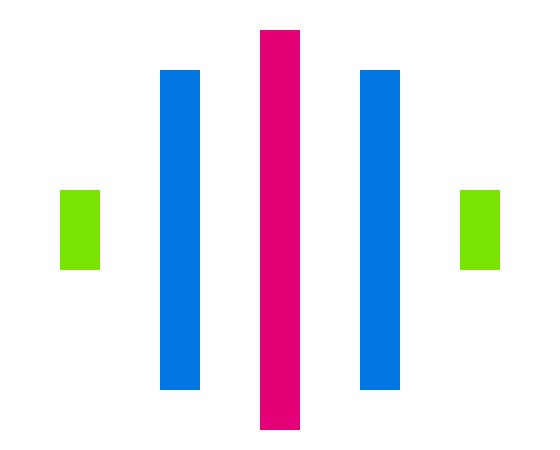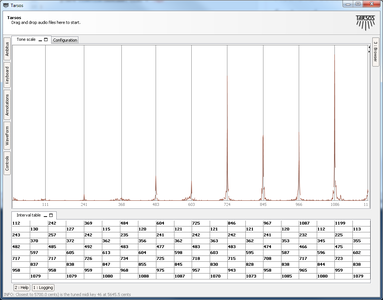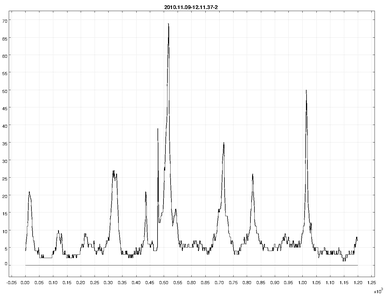~ Groovy Tarsos Scripting
» By Joren on Tuesday 09 November 2010
There is more to Tarsos then meets te eye. The graphical user interface only exposes some functionality; the API (Application Programmer Interface) exposes all of Tarsos’ capabilities.
Tarsos is programmed in Java so the API is accessible trough Java and other programming languages targeting the JVM (Java Virtual Machine) like JRuby, Scala and Groovy. The following examples use the Groovy programming language because I find it the most aesthetically pleasing with regards to interoperability and it gets the job done without getting in your way.
To run the examples a copy of the Tarsos JAR-file needs to be added to the Classpath and the Groovy runtime must be installed correctly. I’ll leave this as an exercise for the reader: godspeed to you, brave soul. Quick protip: placing a copy of the jar in the extensions directory seems to work best, e.g. see important java directories on mac OS X.
The first example extracts pitch class histograms from a bunch of files and saves them as EPS (Encapsulated PostScript)-files. It iterates a directory recursively and handles each file that matches a given regular expression. In this example the regular expression matches all WAV-files. Batch processing is one of those things scripting is ideal for, doing the same thing with the user interface would be tedious or even mind-numbingly boring, not groovy at all indeed.
```ruby\ import be.hogent.tarsos.*\ import be.hogent.tarsos.util.*\ import be.hogent.tarsos.util.histogram.ToneScaleHistogram\ import be.hogent.tarsos.sampled.pitch.Annotation\ import be.hogent.tarsos.sampled.pitch.PitchDetectionMode
dir = “/home/joren/audio”
FileUtils.glob(dir,”.*.wav”,true).each { file ->\ audioFile = new AudioFile(file)\ pitchDetector = PitchDetectionMode.TARSOS_YIN.getPitchDetector(audioFile)\ pitchDetector.executePitchDetection()\ //get some annotations\ annotations = pitchDetector.getAnnotations()\ //create an ambitus and tone scale histogram\ ambitusHistogram = Annotation.ambitusHistogram(annotations)\ toneScaleHisto = ambitusHistogram.toneScaleHistogram()\ //plot a smoothed version of the histogram\ p = new SimplePlot()\ p.addData 0, toneScaleHisto.gaussianSmooth(0.2)\ p.save FileUtils.basename( file) + “.eps”\ }\ ```
The second example uses functionality that is currently only available trough the API. It takes a MIDI-file and synthesizes it to a wave file using an arbitrary scale. In this case 10-TET. The heavy-work is done by the Gervill synthesizer. The resulting file is available for download, micro—macro?—tonal Bach is great: “BWV 1013 in 10-TET”:[BWV_1013_10-TET.mp3]. The result of “an analysis with Tarsos on the synthesized audio”:[120.png] clearly shows an interval of 120 cents with some deviations.
```ruby\ import java.io.File\ import be.hogent.tarsos.midi.MidiToWavRenderer\ import be.hogent.tarsos.util.ScalaFile
midiFile = new File(“BWV_1013.mid”)\ outFile = new File(“out.wav”)
tuning = [0,120,240,360,480,600,720,840,960,1080] as double []
MidiToWavRenderer renderer\ renderer = new MidiToWavRenderer()\ renderer.setTuning(tuning)\ renderer.createWavFile(midiFile, outFile)\ ```
An extended version of this second example script could be used to generate a dataset with audio and corresponding tone scale information on the fly. The dataset could then be used as a baseline.
The API is not yet well documented and is still in flux or more correctly: superflux. Note to self: I will provide documentation and a number of useful examples when the dust settles down. I’m not even sure if I will stick with Groovy. Scala has a nice Lispy feel to it and seems more developed. Groovy has a less steep learning curve, especially if you have some experience with Ruby. JRuby is also nice but the interoperability with legacy Java looks like an ugly hack.


